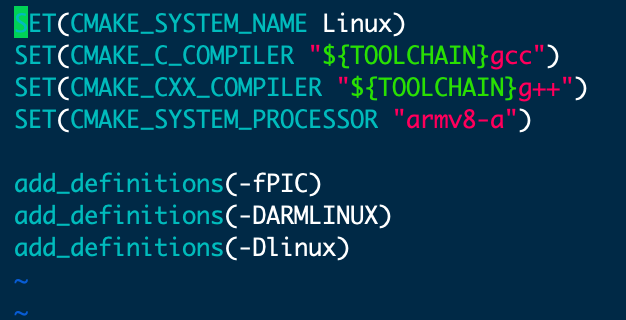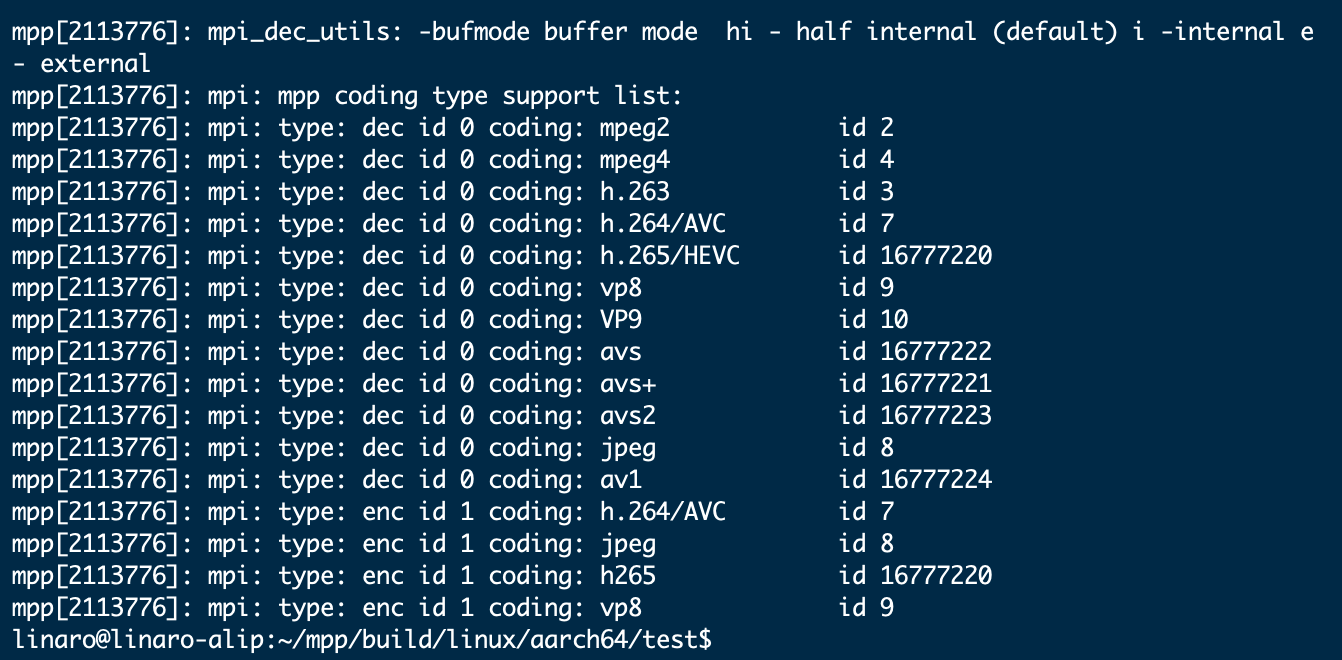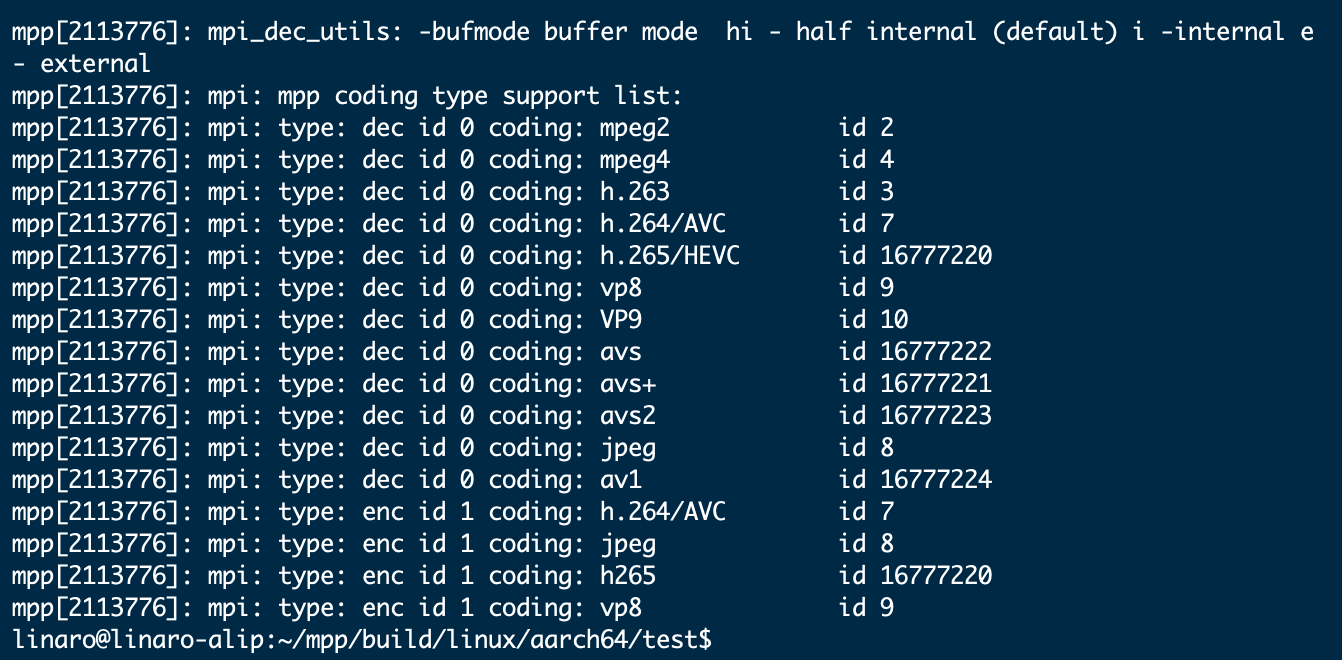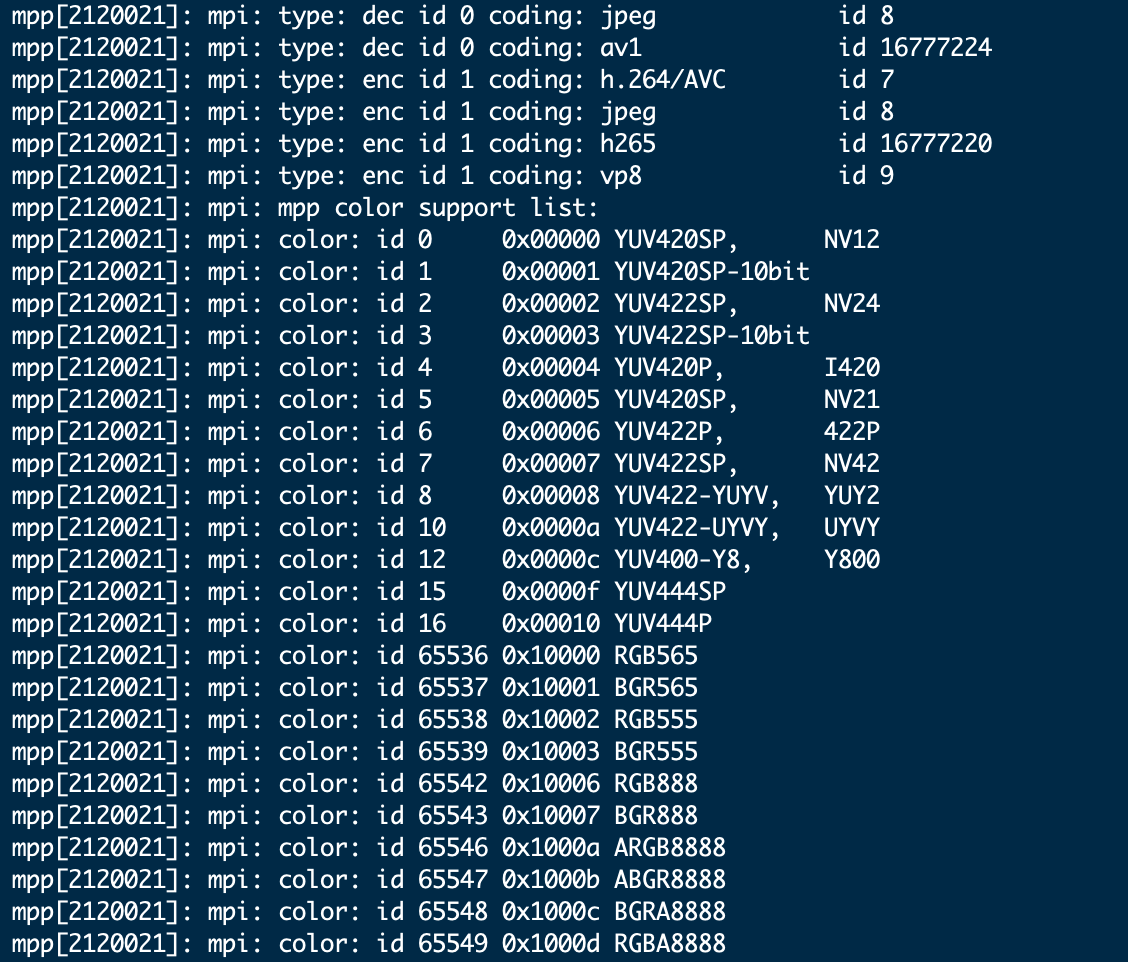Video Codec - Based on MPP Library
1. MPP Introduction
The Media Process Platform (MPP) provided by Rockchip is a general-purpose media processing software platform for Rockchip chip series. This platform shields application software from complex underlying chip-related processing, aiming to shield differences between different chips and provide users with a unified Media Process Interface (MPI). MPP provides the following functionalities:
-
Video Decoding
H.265 / H.264 / H.263 / VP9 / VP8 / MPEG-4 / MPEG-2 / MPEG-1 / VC1 / MJPEG / AV1 -
Video Encoding
H.265 / H.264 / VP8 / MJPEG -
Video Processing
Video copy, scaling, color space conversion, field video deinterlacing
Below is the GitHub link to RK's official MPP documentation, including Chinese/English MPP development guides:
https://github.com/rockchip-linux/mpp/tree/develop/doc
2. Obtaining and Compiling RKMPP Library
2.1. Test Environment
- RK official MPP library address: https://github.com/rockchip-linux/mpp
2.2. Install Related Dependency Tools
sudo apt update
sudo apt install -y git cmake
2.3. Pull RK Official MPP Repository
git clone https://github.com/rockchip-linux/mpp.git
2.4. Compilation
-
Navigate to the corresponding compilation path for aarch64:
cd mpp/build/linux/aarch64/ -
Modify the cross-compilation configuration file to specify the compilers gcc and g++ (usually default settings are fine):
vim arm.linux.cross.cmake

-
Run the bash script and compile (the compilation process takes about 4 minutes):
./make-Makefiles.bash
make -
After compilation, you will find many files in the directory.

- Navigate to the
testdirectory, where you will find some test programs generated during compilation.

3. Video Decoding
The decoder demo includes the mpi_dec_test series of programs, including single-threaded mpi_dec_test using decode_put_packet and decode_get_frame interfaces, multi-threaded mpi_dec_mt_test, and multi-instance mpi_dec_multi_test.
3.1. Test Environment
- Test Operating System: Debian 12
3.2. Command Parameters for mpi_dec_test
3.2.1. View Command Parameters for mpi_dec_test in Terminal
-
Open two terminals, and in one terminal, input the following command to monitor log output:
sudo tail -f /var/log/syslog -
Execute the
mpi_dec_testtest program in the other terminal:mpi_dec_test -
After executing the test program, the log will print the following help documentation:

3.2.2. Description of Command Parameters for mpi_dec_test
| Command Parameter | Description |
|---|---|
-i | Input stream file. |
-o | Output image file. |
-w | Image width in pixels. |
-h | Image height in pixels. |
-t | Protocol type of the stream file. |
-f | Image color space format and memory layout, default is NV12. |
-n | Maximum number of decoded frames. If the stream is long during testing, only the first n frames can be output. |
-s | Number of MPP instances, default is 1. |
-v | Log options: q for silent flag; f for fps display flag. |
-slt | Output checksum file corresponding to the frame. |
-help | Open help documentation. |
Tips
- Among the command parameters of
mpi_dec_test, the input file (i) and stream type (t) are mandatory configuration parameters, while other parameters such as output file (o), image width (w), image height (h), and number of decoded frames (n) are optional and can be configured according to different test requirements. - Among the command parameters of
mpi_dec_test, the checksum file corresponding to the output frame (slt) converts the output frame data into the corresponding cyclic redundancy checksum (specific logic can be found inutils/utils.c). The size of the checksum file is often only a few kB. In the chip's slt test, converting the comparison of output frame files into the comparison of checksum files can significantly shorten the test cycle.
3.2.3. Explanation of Protocol Types Supported by MPP Decoding
MPP supports decoding types:
MPEG2/4, H.263/4/5, VP8/9, and JPEG, etc. The number after id corresponds to the parameter value of different encoding formats.

Tips
- The encoding formats (
t) supported by the input files of the MPP library are MPEG2/4, H.263/4/5, VP8/9, and JPEG, etc. The number after id corresponds to the parameter value of different encoding formats. The parameter values come from the definition of OMX. It is worth noting that the parameter values of HEVC and AVS formats are significantly different from other formats.
3.3. Decoding Demo
Here, the decoding process of the video test.mp4 is demonstrated as an example.
Tips
The mp4 decoding process is mainly divided into two steps. The first step is to convert mp4 into a pure video type supported by the mpp library (e.g., h264), and the second step is to decode the converted video using the mpp library.
3.3.1. mp4 to h264
mp4 to h264 is implemented here using the FFmpeg tool. For other uses of the FFmpeg tool, refer to the corresponding chapter.
sudo apt update && sudo apt install -y ffmpeg # Install ffmpeg tool
ffmpeg -i test.mp4 -c:v libx264 01.h264
Note
Here, test.mp4 is the source file name to be converted, and 01.h264 is the output file name.
3.3.2. h264 Decoding
This step mainly decodes the 01.h264 file. Open two terminals, and in one terminal, input the following command to monitor log output:
sudo tail -f /var/log/syslog
Execute the decoding program in the other terminal:
mpi_dec_test -i 01.h264 -t 7 -n 60 -o 01.yuv
Note
The above command decodes 01.h264 and saves it as 01.yuv. Here, -i indicates the input file, -t 7 indicates the protocol type of the input stream file is H.264, -n 60 indicates decoding 60 frames, and -o indicates the output file.
Partial decoding log output is as follows:
(This section omits log content)
4. Video Encoding
The encoder demo includes the mpi_enc_test series of programs, including single-threaded mpi_enc_test and multi-instance mpi_enc_multi_test.
4.1. Test Environment
- Test Operating System: Debian 12
4.2. Command Parameters for mpi_enc_test
4.2.1. View Command Parameters for mpi_enc_test in Terminal
-
Open two terminals, and in one terminal, input the following command to monitor log output:
sudo tail -f /var/log/syslog -
Execute the
mpi_enc_testtest program in the other terminal:mpi_enc_test -
After executing the test program, the log will print the following help documentation:

4.2.2. Description of Command Parameters for mpi_enc_test
| Command Parameter | Description |
|---|---|
-i | Input image file. |
-o | Output stream file. |
-w | Image width in pixels. |
-h | Image height in pixels. |
-hstride | Distance between adjacent rows in the vertical direction, in bytes. |
-vstride | Interval between image components in rows, unit is 1. |
-f | Image color space format and memory layout, default is NV12. |
-t | Protocol type of the stream file. |
-tsrc | Source stream format, only used when testing overall codec performance. |
-n | Maximum number of decoded frames. If the stream is long during testing, only the first n frames can be output. |
-g | gop reference mode, corresponding to different TSVC streams. |
-rc | Bitrate control mode. 0:VBR; 1:CBR; 2:FIXQP; 3:AVBR. |
-bps | Bitrate constraint parameters. Command format: bps_target:bps_min:bps_max. |
-fps | Input/output frame rate control, default is 30. This command parameter only indicates the ratio between input frame rate and output frame rate, and is unrelated to actual frame rate. |
-qc | Quality control. |
-s | Number of MPP instances, default is 1. |
-v | Log options: q for silent flag; f for fps display flag. |
-ini | Additional encoding configuration file ini (not yet effective). |
-slt | Output checksum file corresponding to the stream. |
Tips
- Among the command parameters of
mpi_enc_test, image width (w), image height (h), and stream type (t) are mandatory configuration parameters, while other parameters such as input file (i), output file (o), number of encoded frames (n), and color space format and memory layout (f) are optional. If no input file is specified,mpi_enc_testwill generate a default color bar image for encoding. - The command parameters of
mpi_enc_testprovide a variety of bitrate control schemes. Users can control the bitrate of the output stream through bitrate control mode (rc) and bitrate constraint parameters (bps). Bitrate control mode (rc) includes variable bitrate mode (VBR), constant bitrate mode (CBR), qp correction bitrate mode (FIXQP), and adaptive bitrate mode (AVBR), with the default mode being VBR; bitrate constraint parameters (bps) provide reference for configuring bitrate boundaries within MPP. - Among the command parameters of
mpi_enc_test, when the log option (v) isq, MPP daily logs are turned off; when the log option (v) isf, average frame rate and current frame rate are printed once per second.
4.2.3. Explanation of Protocol Types Supported by MPP Encoding
MPP supports encoding types:
H.265 / H.264 / VP8 / MJPEG, etc. The number after id corresponds to the parameter value of different encoding formats.
Tips
- The encoding formats (
t) supported by the input files of the MPP library are H.265 / H.264 / VP8 / MJPEG, etc. The number after id corresponds to the parameter value of different encoding formats.
4.2.4. Explanation of Image Color Space Format and Memory Layout
Image color space formats are divided into YUV and RGB categories. MPP supports various memory layouts (f), and the number after id corresponds to the parameter value of different memory layouts. It is worth noting that the parameter values of YUV and RGB formats are significantly different.
4.3. Encoding Demo
Here, the encoding process of the 01.yuv file decoded above is demonstrated as an example.
Tips
This mainly demonstrates how to encode a yuv file into h265 using the mpp library and how to convert h265 into mp4 using ffmpeg.
4.3.1. yuv Encoding to h265
Open two terminals, and in one terminal, input the following command to monitor log output:
sudo tail -f /var/log/syslog
Execute the encoding program in the other terminal:
mpi_enc_test -i 01.yuv -w 1920 -h 1080 -t 16777220 -o 01.h265 -n 20
Note
The above command encodes 01.yuv and saves it as 01.h265. Here, -i indicates the input file, -w 1920 specifies the pixel width as 1920, -h 1080 specifies the pixel height as 1080, -t 16777220 indicates the protocol type of the output stream file is H.265, -n 60 indicates decoding 60 frames, and -o indicates the output file.
Partial encoding log output is as follows:

4.3.2. h265 to mp4
h265 to mp4 is implemented here using the FFmpeg tool.
sudo apt update && sudo apt install -y ffmpeg # Install ffmpeg tool
ffmpeg -i 01.h265 -c:v libx265 -c:a aac -f mp4 0101.mp4
Note
Here, 01.h265 is the H.265 video file name to be converted, 0101.mp4 is the converted MP4 file name, -c:v libx265 encodes the video into H.265 format, -c:a aac encodes the audio into AAC format, and -f mp4 specifies the output format as MP4.
5. Utility Tools
MPP provides some unit test tools that can test the software and hardware platform as well as the MPP library itself:
-
mpp_info_test
Used to read and print the version information of the MPP library. When reporting issues, you can attach the printed information. -
mpp_buffer_test
Used to test whether the kernel's memory allocator is functioning properly. -
mpp_mem_test
Used to test whether the C library's memory allocator is functioning properly. -
mpp_runtime_test
Used to test whether some software and hardware runtime environments are functioning properly. -
mpp_platform_test
Used to read and test whether the chip platform information is functioning properly.

